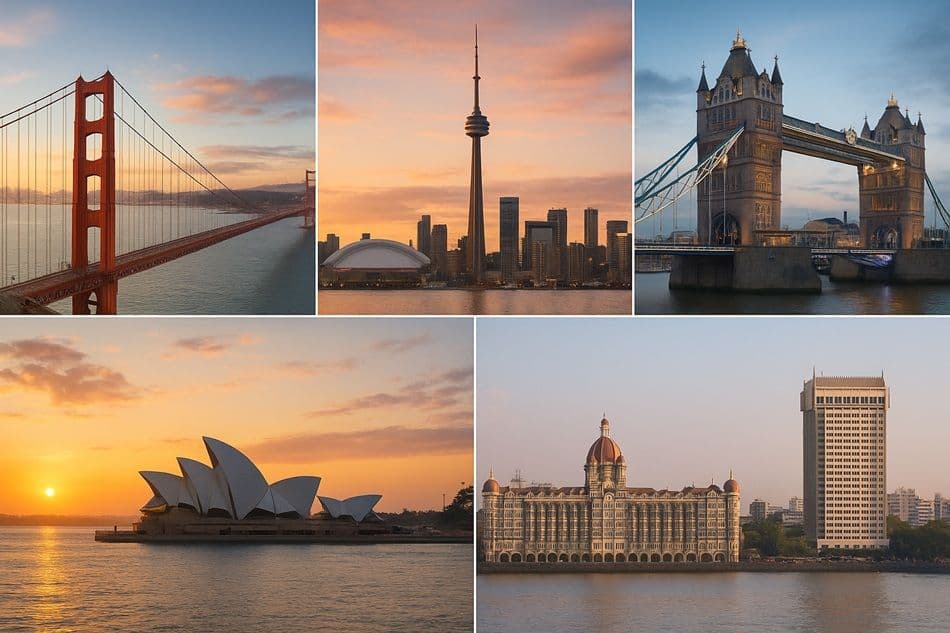Ask GRAI Anything
Your Real Estate Questions, Answered Instantly via Chat


Help us make GRAI even better by sharing your feature requests.

For most of modern history, cities were magnets. People didn’t just move to them for work - they moved to belong.
The energy, the density, the chance to start over.
But as the 2020s unfold, something has quietly broken in the global urban story. The world’s great cities - New York, London, San Francisco, Toronto, Sydney - are pricing out the very people who gave them life.
And while skylines still rise, populations are beginning to fall.
Urban economies thrive when talent and affordability coexist. But in 2025, that equilibrium has vanished almost everywhere.
| City | Median Rent (2025) | Rent-to-Income Ratio | Population Trend |
|---|---|---|---|
| San Francisco | $3,400/month | 48% | ↓ 7% since 2020 |
| Toronto | C$2,800/month | 52% | ↓ 2.2% since 2023 |
| London | £2,500/month | 75% | Flat |
| Sydney | A$3,050/month | 46% | ↑ 2% YoY |
| Mumbai | INR 1.5 crore (avg “affordable”) | 14× median income | Rising, but polarizing |
Across all these markets, one metric tells the story: income growth of 2-3% vs rent growth of 10-15%.
Even high earners are stretching, and middle-income households are migrating - not because they want to, but because they must.
Access city real estate insights for Sydney and Mumbai
The pandemic didn’t create urban flight - it accelerated it. Hybrid work gave knowledge workers geographic freedom, and cost-of-living crises turned that freedom into movement.
New York and San Francisco together lost over 3,60,000 residents between 2020-2024
Toronto’s core downtown population shrank for the first time in decades.
London’s Zone 1 population is aging, while commuter towns like Reading and Brighton are growing twice as fast (ONS).
The story repeats across continents: People are leaving not because they dislike cities - but because cities no longer make economic sense.
Despite slowing population growth, prices haven’t fallen much. That’s because global capital, not local wages, now drives urban real estate.
Institutional and overseas investors treat prime-city property as a store of wealth, not a home - locking in value even when occupancy falls.
In central London, foreign ownership of new builds and is significantly lower than 55%. In Dubai, 60-65% of transactions are investor-driven.
This isn’t a housing market anymore - it’s an asset market with a housing problem.
Also Read: Housing Affordability Is Gone: What Smart Buyers Do Now
Cities don’t just lose residents - they lose identity.
Artists, teachers, small entrepreneurs - the people who make a place feel alive - are the first to go.
In San Francisco, galleries and live music venues are closing faster than restaurants.
In Berlin and London, studio spaces have turned into luxury flats.
In Sydney, small retail strips are turning into ghost rows as independent tenants exit.
The result?
Vibrant cities risk becoming hollow luxury shells - rich in architecture, poor in life. The irony of prosperity: when a city becomes too successful, it stops being livable.
The people leaving aren’t abandoning cities altogether - they’re redefining what a city means.
Second-tier metros like Austin, Lisbon, and Kuala Lumpur are absorbing the outflow.
Peripheral belts - Brighton for London, Kitchener for Toronto, Boulder for Denver - are booming.
Emerging hubs such as Mexico City, Tallinn, and Tbilisi attract digital professionals priced out of traditional capitals.
The future of “urban” isn’t vertical. It’s distributed - a network of mid-sized, affordable, connected hubs powered by hybrid work and global mobility.
Governments are struggling to respond. Rent controls ease symptoms but distort supply. Incentives for affordable housing often get captured by developers.
The OECD’s Housing 2025 Review warns:
“Without structural reform, affordability gaps in global cities may widen for another decade - even under falling population.”
Policy is reactive. Migration is not.
With GRAI, you can model how affordability, migration, and capital flow will reshape global cities through 2030:
“Forecast population shifts across 25 global metros under affordability stress.”
“Simulate ROI differences between legacy and emerging urban markets.”
“Compare rent inflation to wage growth across OECD cities.”
“Model second-tier city expansion under hybrid work adoption.”
Understand Global Urban Shifts - Talk to GRAI: https://internationalreal.estate/chat
Cities don’t collapse overnight - they evolve in silence.
The next decade won’t be defined by urban growth, but by urban redistribution - of people, jobs, and value.
The winners won’t be the cities with the tallest towers.
They’ll be the ones that remember the simple math that built them: people first, prosperity second.